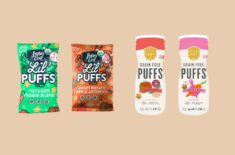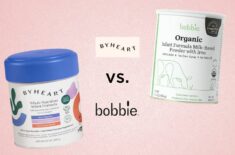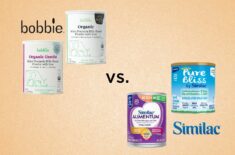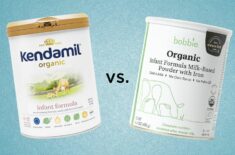Overview
Do you think your 4-month-old baby is ready to take their first bite of solid food?
If yes, then there are things you need to know. This milestone is worth remembering but also needs careful planning, mama.
Is it safe to introduce solid foods before six months old?
What are the risks and benefits of the early introduction of solids?
Experts recommend introducing solids at six months of age. However, many pediatricians also give a green light at four months. It’s best to check if your baby shows signs of readiness like strong head and neck control.
Your baby’s cues are important factors as you weigh your options whether you should start or delay the introduction of solid food. There are also pros and cons to introducing your baby to solids before the recommended age.
Here, we made a comprehensive guide on what you need to know to introduce solids to your four-month-old baby. By the end of this article, you’ll know what signs of readiness to look for and how to start baby-led weaning. You’ll also learn about the risks and benefits of giving your little one solids at four months–and more.
What is BLW?
Baby-led weaning (BLW) is an approach that lets your baby skip the traditional purée spoon-feeding and allows them to self-feed with appropriately-sized finger foods. Your baby can decide what they want from the foods you offer and how much they can eat. The approach was popularized by Gill Rapley, the author of “Baby-Led Weaning: The Essential Guide to Introducing Solid Foods-and Helping Your Baby to Grow Up a Happy and Confident Eater.”
What Are The Benefits Of BLW?
Evidence backs the benefits of BLW:
- This method promotes self-independence because your baby can decide on the food they like from the options you offer and how much they want to eat. (1)
- Lessens the risk of picky-eating (1)
- Lowers the risk for obesity or becoming overweight later in life (2)
- It encourages your baby’s hand-eye coordination, the ability to simultaneously use the hands and eyes in doing various activities. (1)
- It can help foster good eating habits (1)
- It can make feeding time convenient because your baby can join with the rest of the family.
To learn about the benefits and more, we’ve written a comprehensive BLW Guide.
What Age Can You Start Baby-Led Weaning?
The AAP (American Academy of Pediatrics) recommends introducing baby’s first foods at six months. However, many pediatricians say it’s okay to start at four months, as long as your baby displays signs of readiness. (Listed below.)
According to Gill Rapley, when your baby shows signs of readiness, then you should go for it: (3)
“However, my actual position, based on my research and my clinical experience, is that whatever an individual baby is ready to do is probably what’s right for that baby.
There is good reason to believe that those developmental abilities that are visible to us (sitting upright etc.) are a reliable indicator of the maturity of that baby’s (internal) digestive system – nature very rarely makes mistakes.
So, if a full-term, healthy baby can (genuinely) sit upright, grasp food and get it to his mouth UNAIDED, then he’s probably ready to do just that.
If he’s also ready to chew it – and perhaps even swallow it –that’s fine, but it is more likely that these skills will follow in due course.”
Can You Start Baby-Led Weaning Before 6 Months?
One of the reasons why experts recommend delaying the introduction of solids is to ensure that your baby exclusively breastfeeds or formula-feeds until six months of age. Until about twelve months, your baby’s main source of nourishment should still be breast milk or formula milk, according to experts. (4)
However, many pediatricians say it’s okay to start at four months or as soon as your baby shows signs of readiness. (5)
Can You Give Solid Foods To Your 4-Month-Old Baby?
Many experts and pediatricians say it’s okay to give your 4-month-old baby solid foods if they are developmentally ready. However, the AAP still recommends delaying up to six months of age.
When feeding your baby, it’s a good idea to reduce the risk of choking by ensuring foods are cut appropriately. It’s also advisable to be cautious when introducing allergenic foods like peanut butter.
You can seek the advice of a pediatrician or a healthcare professional when introducing solid foods to your baby under six months of age.
Benefits, Dangers, & Drawbacks Of Giving Solid Foods At 4 Months
Benefits
- Early introduction of allergens to babies can reduce the risk of developing food allergies later in life. (6)
- May increase their willingness to try new tastes and textures (7)
- Lower risk of having feeding problems later in life (7)
- Can help promote better sleep (This claim is still debatable as there are contradicting studies about it. More on this below.)
Dangers & Drawbacks
- Higher risk for obesity or diabetes later in life (There are contradicting studies about this claim.) (8)
- Your baby’s motor skills used for eating solids may not be fully developed. (9)
- Their digestive system might not be mature enough.
- Increased risk for iron-deficiency anemia (10)
Top Signs of Readiness
When trying to consider if your baby is ready for solids, here are the top three questions to ask: (11)
- Can my baby hold his or her head in an upright position and sit with no support?
- Can my baby swallow food?
- Can my baby pick up the food and put it in their mouth?
Common Signs Usually Mistaken As Readiness
These are normal behaviors that your baby may show but they don’t necessarily mean they’re signs of readiness: (11)
- Asking for more milk feedings or increase in appetite
- Chewing their fists
- Nighttime awakenings when they’ve already learned to sleep through
Key Developmental Milestones
Each baby is unique and will learn skills and abilities at their own pace.
Development milestones are meant to be a guide on the changes your baby will go through as they get older. Here are some of the developmental milestones per age: (12)
4 Months
- Holds an object you place in their hands
- Smiles, looks, and makes sounds when they see you
- Opens their mouths when they see a breast or a bottle
- Has good head control when being held
- Brings their hands to their mouth
6-9 Months
- Recognizes familiar people
- Moves objects by “raking” them with the fingers
- Passes toys or objects from one hand to the other
- Closes their mouth when they don’t want food anymore
- Can sit by themselves
- Grabs objects they want
- Starts to look for objects they dropped
9-12 Months
- “Cruising,” or the ability to walk while holding on for support
- Develops pincer grasp, the ability to hold objects between thumb and forefinger
- Your baby can wave “bye-bye” and understand when told “no.”
- Plays “hide and seek” with objects
- Improves hand-eye coordination, the ability to use their hands and eyes simultaneously in an activity
Weaning Early & Sleep
There’s much controversy on the belief that feeding your baby early solid food would help them sleep through the night. As a general rule, experts say that solid food won’t help your baby sleep longer through the night. (11)
However, a 2018 study looked at the effects of early weaning on babies’ sleeping patterns. The study showed that babies introduced to solid foods earlier than six months slept significantly longer and had less nighttime awakening than those who started at six months of age. It also concluded that babies and parents enjoyed a relatively good sleeping experience. (13)
It gave babies an extra 16 minutes more of sleep per night, resulting in almost two hours of extra sleep per week for parents. Babies who weaned early also had lesser sleep problems, such as crying or irritability. (13)
Premature Babies & Weaning Early
Babies born prematurely may display delays in gross motor development and organ maturity. It’s recommended that preterm babies wait until they reach around five to seven months of their actual age to start complementary feeding. (14)
However, it may not always be the case since each baby is unique. Some healthy preterm babies can catch up on their development. It’s recommended that babies be assessed based on their signs of readiness. (14)
If you start your preterm baby on solids too soon, here are the possible risks: (14)
- Risk for allergies because your baby’s gut may not be mature enough for solids.
- May still have a tongue-thrust reflex, the act when babies still cannot swallow, and their tongue pushes food away.
- Might still frequently gag or cough when fed with solids
What Foods Can I Introduce To My 4-Month-Old Baby?
There aren’t any strict food guidelines when it comes to complementary foods. However, it’s best to let your baby eat a variety of foods and keep a healthy and balanced diet. Wherever possible, choose whole foods like fruits or veggies in their whole form around 80% of the time. If you can, choose foods that are certified organic, non-GMO, or options that are minimally processed, refined, or contain additives.
However, it’s best to be cautious when introducing new foods. You can choose soft foods to avoid choking hazards.
Here are some suggested first foods:
- Banana
- Avocado
- Soft peaches
- Sweet potato cooked until fork-tender
- Puréed meats
- Zucchini
- Pumpkin
- Strawberries and blueberries
- Iron-rich foods like small pieces of meat, poultry, and beans
How To Cut Foods For A 4-Month-Old Baby According To BLW
To make mealtime safe for your little one, it’s essential to cut food appropriately. At this age, most babies haven’t developed their pincer grasp yet, or the ability to hold objects between the thumb and forefinger.
You can cut foods into long, thick sticks they can grasp in their palms. Eating solids at this stage is still a practice session for your baby to explore new tastes and textures.
How Do I Know If My 4-Month-Old Baby Is Full?
At four months old, feeding your baby solid foods is meant to be a mainly sensory experience. It’s an opportunity for your baby to explore different tastes and textures.
While worrying if your baby is getting enough nutrients from solids is normal, you don’t have to sweat it. Your baby’s primary source of nutrition is should still be breast milk or formula until they’re about 12 months old.
In BLW, your baby gets to decide what foods to eat from your offered choices and how much they want. It can be helpful if you recognize the signs that your baby is already full.
Here are some of them: (15)
- When you offer food, your baby closes their mouth.
- Your baby turns their heads away from food.
- They can also use hand movements to signal that they have had enough food.
Will Your Baby Get Enough Nutrients When You Start BLW At 4 Months?
At four months old, your baby’s introduction to solids is just a practice session. It’ll be a good opportunity for your baby to get comfortable with new tastes and textures.
When you offer food, there’s a big possibility that your baby will just lick it to taste or play with it. That’s okay. Your little one’s main source of nourishment will still be breast milk or formula milk.
Food Safety For BLW At Four Months
Here’s what you need to know about potential food allergens, foods to avoid, and how to practice BLW safely.
A Note On Allergies & Unsafe Foods
The AAP says introducing allergens to babies starting at four to six months can help lower their risk of developing food allergies. However, babies under four months old shouldn’t be given food. (6)
You can introduce common allergens in small amounts when you start complementary feeding.
Here are some of them: (5)
- Wheat
- Gluten
- Dairy products like yogurt or cheese
- Eggs
- Soy
- Fish
- Sesame
- Peanuts
Seek the advice of your pediatrician or registered dietitian before you start introducing allergens to your baby, especially if there’s a family history of any type of food allergy or intolerance.
Here’s an in-depth article on how to safely introduce bread and gluten to your little one.
Foods You Need To Be Cautious About
Highly Processed Foods Like:
- Hotdogs
- Nuggets
- Bacon
- Sausage
- Ham
- Liver pâté
Avoid Honey
Avoid giving honey to your baby during their first year of life. That might put them at risk for infant botulism, a serious illness characterized by constipation, weak movements, and difficulty in breathing. (16)
Other Food Safety Tips
At four months old, your baby’s immune system is still developing. Here are some food safety tips to safeguard against bacteria and viruses that might cause serious infections or complications like kidney failure or botulism: (17)
- Before preparing your baby’s food, always wash your hands.
- Always keep your baby’s hands clean.
- It’s not advisable to feed your baby from a jar. Instead, get a portion of baby food from a jar and transfer it to a bowl. This “double-dipping” might introduce bacteria to your baby and the food.
- Throw away leftovers from your baby’s plate or bowl.
- Meat can only be kept for a day in the refrigerator. (17)
Does BLW Increase The Risk Of Choking?
One of the concerns parents have with BLW is the risk of choking. However, studies have shown no increased incidence of choking in BLW compared with the traditional spoon-fed approach.
However, experts still suggest that parents or caregivers be cautious when offering foods that can be choking hazards. (18)
What’s The Difference Between Choking And Gagging?
Gagging is perfectly normal in weaning, whether spoon-feeding or baby-led weaning. It’s your baby’s natural reflex to protect themselves from choking. As your baby develops and becomes comfortable eating solid foods, their gag reflex will also lessen. (19)
Meanwhile, choking happens when there’s a blockage in their windpipe, preventing them from breathing. Choking is a life-threatening incident. It’s better to know the early signs of choking and learn how to properly remove the blockage.
Here are some possible signs of choking:
- Difficulty breathing
- Struggle to cough
- Soft sound when inhaling
- Bluish skin color
- Cannot make sounds to cry or be completely quiet
- Unresponsiveness
How To Start With BLW
You don’t need much to start with BLW, but here are some things that many parents find useful:
- Cloth or silicone bibs
- Comfortable high chair
- Tray or a messy mat
- Food-grade silicone or BPA-free spoons, bowls, and baby cups
Start offering food in small portions. It may be good to start with single-ingredient foods like avocado or foods without salt or added sugar. When introducing new foods, wait for one to three days to check for any adverse effects such as vomiting or diarrhea.
When your baby starts to fuss or shows signs of not wanting to continue, you can stop the feeding. Your baby doesn’t need to be forced to finish their portions. BLW can help your baby recognize satiety feelings and stop eating once they feel full. (20)
Always supervise your baby during mealtimes. Even better, you can let your baby join in on family mealtimes.
Is It Worth It To Wait Until Six Months To Introduce Solids?
Each baby is unique, and no one knows your baby better than you. Early and delayed introduction of solid foods both has their pros and cons. The decision to wait will be based on your intention.
If you want to reduce your baby’s risk for allergies, they might benefit from introducing small amounts of allergens at four months.
But if you’re considering complementary feeding for added nutrients, you can still wait until six months. Breast milk or formula is still enough until six months of age.
Whatever you choose, as long as you’re honoring your baby’s readiness signs, you can’t go wrong. You’ve got this, mama.
REFERENCES
:
- https://www.annabelkarmel.com/baby-led-weaning-pros-cons/
- https://bmjopen.bmj.com/content/2/1/e000298
- http://www.rapleyweaning.com/assets/How_early_is_too_early.pdf
- https://www.fammed.wisc.edu/files/webfm-uploads/documents/outreach/im/handout_baby-led_weaning.pdf
- https://www.mayoclinic.org/healthy-lifestyle/infant-and-toddler-health/in-depth/healthy-baby/art-20046200
- https://www.jacionline.org/article/S0091-6749(19)31031-0/fulltext
- https://www.frontiersin.org/articles/10.3389/fped.2021.654171/full
- https://www.cdc.gov/mmwr/volumes/69/wr/mm6947a4.htm
- https://www.stanfordchildrens.org/en/topic/default?id=infant-feeding-guide-90-P02694
- https://www.nature.com/articles/srep44726
- https://www.unicef.org.uk/babyfriendly/wp-content/uploads/sites/2/2008/02/Start4Life-Introducing-Solid-Foods-2015.pdf
- https://www.cdc.gov/ncbddd/actearly/milestones/index.html
- https://jamanetwork.com/journals/jamapediatrics/fullarticle/2686726
- https://www.health.qld.gov.au/__data/assets/pdf_file/0024/650805/paed_preterm_solids.pdf
- https://www.cdc.gov/nutrition/infantandtoddlernutrition/mealtime/signs-your-child-is-hungry-or-full.html
- https://www.healthychildren.org/English/health-issues/conditions/infections/Pages/Botulism.aspx
- https://www.eatright.org/homefoodsafety/safety-tips/food-poisoning/food-safety-tips-for-young-children
- https://www.semanticscholar.org/paper/No-difference-in-self%E2%80%90reported-frequency-of-choking-Brown/f0b12adbbcb8a84a0a73df8d20d6c6f5c27095a5
- https://preventallergies.org/baby-gagging-vs-choking/
- https://onlinelibrary.wiley.com/doi/full/10.1111/j.2047-6310.2013.00207.x












